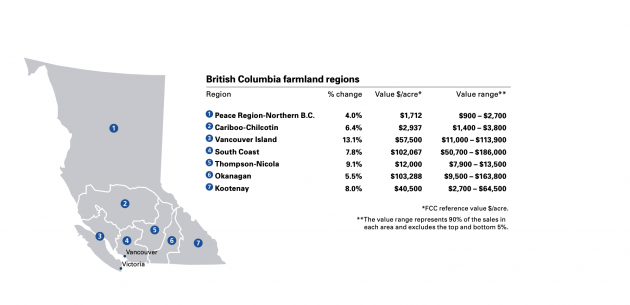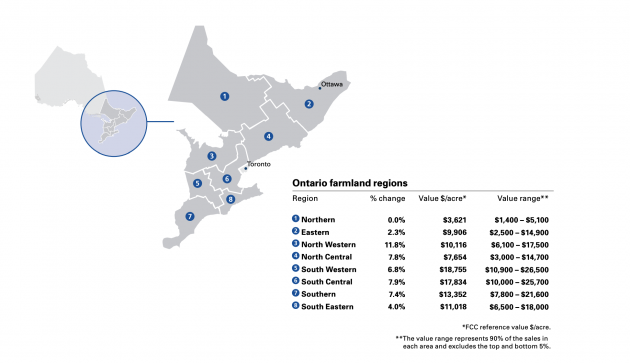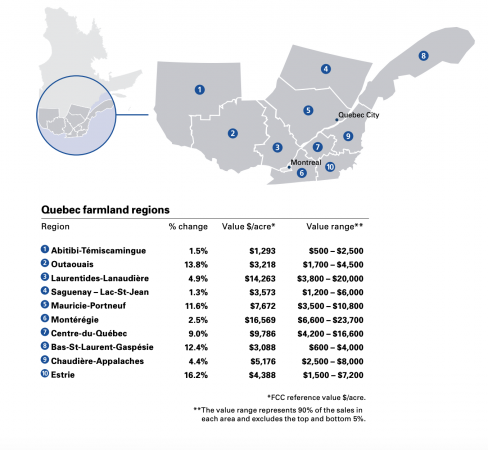
News
Business
Canadian farmland values continue to soften amid uncertainty, FCC reports
The highest provincial increases in 2019 were observed in two of the Atlantic provinces, Prince Edward Island and New Brunswick.
April 6, 2020 By Fruit and Vegetable
The average value of Canadian farmland increased by 5.2 per cent in 2019, the smallest increase over the past decade, according to the latest FCC Farmland Values Report.
The 2019 increase follows gains of 8.4 and 6.6 per cent in 2017 and 2018, respectively, and becomes part of a five-year trend of softening growth in average farmland values.
“The days of sharp increases in farmland values continue to be replaced by more modest growth,” said J.P. Gervais, FCC’s chief agricultural economist. “Changes in commodity prices, uncertainty around global trade and some challenging weather conditions may be tapping the brakes on an otherwise healthy and robust Canadian agriculture industry.”
The highest provincial increases in 2019 were observed in two of the Atlantic provinces: Prince Edward Island with an average increase of 22.6 per cent and New Brunswick with an average increase of 17.2 per cent.
Ontario, Quebec and Saskatchewan reported average increases slightly above the national average at 6.7, 6.4 and 6.2 per cent, respectively, while British Columbia was closest to the national average at 5.4 per cent. Manitoba, Alberta and Nova Scotia had average increases below the national average at four, 3.3 and 1.2 per cent, respectively.

British Columbia saw an average increase in farmland values of 5.4 per cent in 2019, with Vancouver Island reporting the largest increase in the province at 13.1 per cent. Photo courtesy of FCC’s Farmland Values Report 2019.

The average value of Ontario farmland increased 6.7 per cent in 2019. The North Western region had the most significant increase at 11.8 per cent. Photo courtesy of FCC’s Farmland Values Report 2019.
For the fourth consecutive year, there was an insufficient number of publicly reported transactions in Newfoundland and Labrador to fully assess farmland values.
Increases in farmland values reported across the country are as wide and varied as the factors that may have influenced them. Average farmland values have increased every year since 1993; however, increases were more pronounced from 2011 to 2015 in many different regions. Since then, Canada has seen more moderate single-digit increases in average farmland values.

All regions of Prince Edward Island saw double-digit increases in farmland for a provincial average increase of 22.6 per cent in 2019. Photo courtesy of FCC’s Farmland Values Report 2019.

The average value of farmland in Quebec increased by 6.4 per cent in 2019. The most significant farmland value increases were in the Mauricie-Portneuf,
Centre-du-Quebec, Estrie, Outaouais and Bas-Saint-Laurent-Gaspésie regions. Photo courtesy of FCC’s Farmland Values Report 2019.
The COVID-19 pandemic makes the current economic environment challenging for farm operations and business owners throughout the entire food value chain.
“Given the uncertainty, I expect farmers, ranchers and food processors to continue being careful with their investments,” said Gervais, encouraging producers to have and maintain a risk management plan that considers a broad range of possible economic changes, such as variable production, volatile commodity prices or disruptions to global trade.
This year’s Farmland Values Report reflects factors that influenced average land values and prices in 2019, prior to the COVID-19 pandemic. Any impact from the pandemic will be captured in future reports.
Print this page